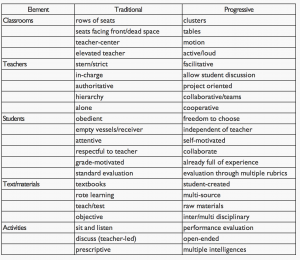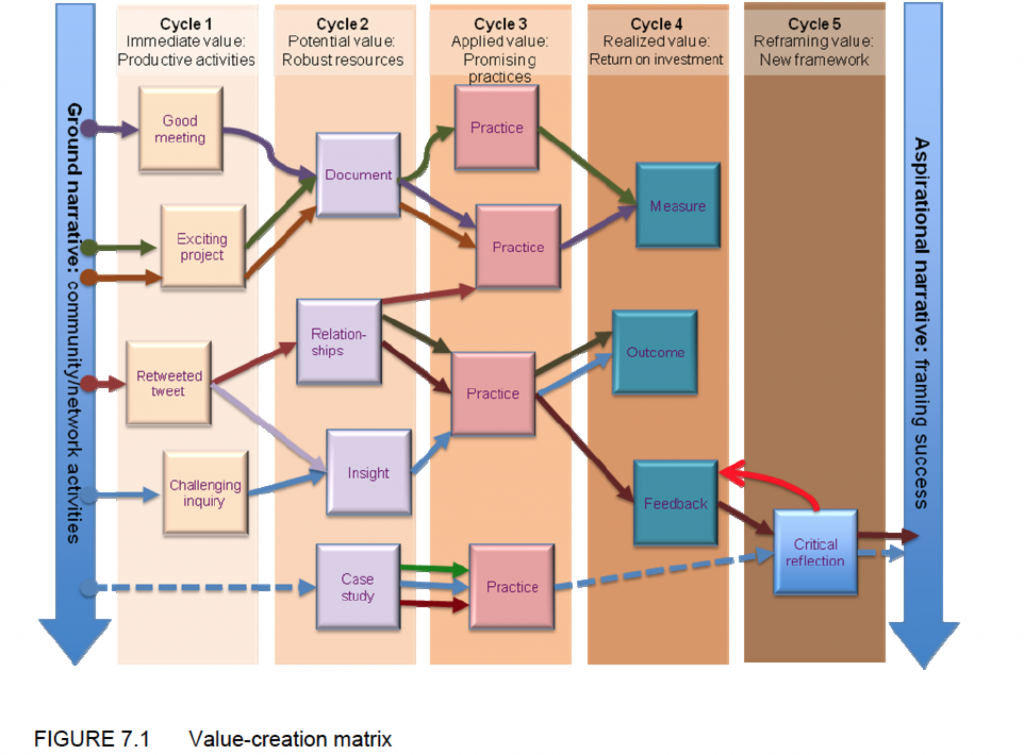Future of BYOD – Emerging Frameworks
In order to understand how BYOD supports new and emerging frameworks for learning, we must first look at what two contrasting philosophies that surround teaching and educational objectives. In an article on ourfutureplanet.org, Tim Powell uses a table that dissects traditional education from progressive education.
In comparing these philosophies, it becomes evident that new and innovative ways of framing progressive education,as a reference to BYOD, is important and useful. The following is an introduction to rethinking our pedagogical practices. These frameworks and models provide ideas/reframing of how BYOD can support a progressive educational philosophy .
Classrooms- What type of physical learning environment should a classroom have for BYOD?
Imagine a classroom where teachers could see what students are thinking and students are able to get their ideas down in a method that suites their optimal learning style. Harvard Business School has done just that with Hives
Text/Materials- What type of materials and resources should teachers use to teach students?
According to the progressive model of education, students should be at the center of their learning. It is important than to understand how collaborative software can be used to achieve this. This model by Brodahl et al, 2009. allows us to conceptualize the interactions between users on a shared google document. (click the picture to see the full article)
Activities- What kind of activities should a student do in a BYOD classroom?
Along with this question, another more important question needs to be asked. What do students value in their learning? The following is a theoretical framework by Etienne Wenger, Beverly Traynor, and Maarten De Laat. (click picture to see full article)
Discussion (please write your answer in the “Leave a Reply” box found below):
1. With reference to the models presented, What would your ideal BYOD classroom look like (Classroom, Text/Materials and Activities?)




I think that the BYOD model lends itself to a collaborative model but because of the isolationist nature of the tech, (seeing as it requires your attention away from other people), I think the activities have to be both intellectual and kinesthetic in that the device is a tool used to organize a bigger social activity.
For example, my classroom is set up like two concentric C’s. This is for a couple of reasons. First it is great for watching films and cartoons, (which we do during one class day of the week. Second is that it encourages social interaction and because there is room to walk around everyone, the “student at the back of the class” issue is resolved. So when students are using their devices they are also able to interact with the people around them and are encouraged to do so.
Joel,
I completely agree. I think that technology should be leveraged in such a way that it is kinaesthetic and facilitates group interaction. I like the concentric c’s seating arrangement, I think given our physical classroom sizes that would work very well. I am going to try that next time I am in a BYOD classroom.
From Shaun
The framework provided by Etienne Wenger, Beverly Traynor, and Maarten De Laat would be representative of my ideal BYOD classroom. If students had reliable access to the internet or technology I would like to see fluidity in the classroom, where students work in various groups to achieve goals, balanced with work individually and sharing with the class. Technology would be seamless and students would have access to both traditional sources like books and also online, or technological resources. Learning could be shared by whichever means was most relevant to documents and students. Students would take feedback from peers and teachers to refine or redefine their work and would reflect on it and the process of learning by using different mediums.
Rebecca,
I think you have made a good point. BYOD classrooms that can keep students engaged by creating value throughout the learning process is what teachers strive for in every lesson. I think the next task for this group of people (MET graduates) is helping our teaching colleagues in understanding how this is possible to leverage technology to achieve this.
From Shaun
I like how Joel has customized a class design to optimize BYOD for the needs and culture of his classroom.
I agree with Rebecca that Wenger et al. provide an interesting and seemingly useful approach to implementing BYOD in the classroom. In fact, I’m beginning to wonder if a similar model could be developed to support the implementation of BYOD in other environments, such as work office environments for example.
But I’m getting ahead of myself.
Frank,
I believe many corporate offices are opening up their policies on BYOD. They are allowing people to bring their own devices in an attempt to keep costs down and to allow employees to use the tools they are familiar with. I actually see this making a greater impact on, what happens to office spaces. I think that the office space is very expensive and we will see more and more companies allow their employees to work from home. Most people in offices email anyways (it’s the fastest form of communication). The times they are a changin’.
From Shaun
I would like to see my classroom set up in pods or group learning environments where students are grouped according to learning preferences. I quite often like to have groups of students work together through a complex math problem to see different solutions. I would also like to have devices for each group to present their solutions to the class using a projector. A collaborative device such as Elluminate for all of the groups to present their work and have access to other resources would also be beneficial. This would also be very helpful for getting all of the work done in class in one place that can be reviewed by the class either on individual devices or a projector. I love giving my students activities that allow them to explore math and understand why something is what it is. I would use an approach where students work together to solve problems individually and in groups using their devices to search the Internet and other resources for reference.
As Joel mentioned earlier, there is no doubt that BYOD lends itself to collaboration not only within the classroom but outside too. In my ideal classroom, I would have students podded together but there discussion would primarily be face to face as we are physically in the same space. The technology would be used to broaden our horizons and connect after school hours with each other or within school hours with other classes across the globe. The level of worldwide collaboration that the Internet affords allows students to collaborate with peers and enhance their learning in ways never seen before. I think Apple TV is a key piece of hardware that everyone needs in their classroom for students to be able to easily and quickly showcase their work. Unfortunately, android devices can’t connect and district firewalls usually prevent it from working properly. Just another one of the limitations that face BYOD.
Manny
Currently my classroom is set up in groups of desks. In the future to support BYOD, I would like to see us leave the use of desks behind and instead move to circular tables with chairs. In my class I like the students work with lots of different students and they often do not like it when other students are requested to sit in their desks. If we moved to tables and chairs no one would feel ownership over a particular space which would be good. I would also remove any teacher’s desk and instead make sure there was space for the teacher at any of the circular tables. Should a teacher need a place for storage I would ensure each teacher had a small cubicle area situated beside other teachers who teach similar subjects and/or ages. I believe that no teacher should be sitting at a desk while interacting with students. Instead they should engaging with their students.
Jen I really like your idea of circular tables. They are so much more social. When you think about going out for a group to a Chinese food restaurant, you can see everyone’s face, hear them and communicate with everyone there. Compare that too a square table where you are limited to who you converse with to people directly beside or across from you.
Circular tables that seat 5-6, a screen in the room that kids can easily project to the class from where they are using their own device, a teacher desk, where they could monitor the online activity and a locked cabinet that would house our ‘extra’ devices for students that could not bring their own.
I think there could still be activities based on reading and responding, but instead of textbooks, kids would be reading from their devices and responding online, and submitting their responses into some sort of cloud.
On top of these more traditional activities, there would be more project based, collaborative learning. If they have to go film something or take a photo, they could go into the hallway or outside to get the shot they need for their group.
I picture the teacher as much more of a facilitator working with students to make their ideas come to life rather than a traditional authoritative figure speaking at the front of the room addressing the whole class. The teacher would be moving around a lot and talking to students more individually and to their groups. I see the teacher in a BYOD classroom as more of a partner in the process of learning.
If I were able to incorporate a BYOD in my classes I would envision a model that allows students the choice to use their (or the school’s) technology in ways that support their work and learning. I would avoid using BYOD as an excuse to play with cool tech toys. It would be used selectively as we navigate through the materials and objectives of the course. The use of BYOD would be implemented to allow for collaboration, communication, and accessing support to the work that we are doing in the class.
Ken
I feel like BOYD is means of allowing for more flexibility and inquiry based learning for students. Hence, I feel that BOYD in my classroom would allow for students to work independently or in groups depending on how they choose to approach the activity. For this to occur my classroom would have to be set up in a manner that would allow students to move around freely. I would want to have tables set up in my room for collaborative work and have desk in another section for individual work. I would want a section of computers in one area of the room for students who do not have their own devices. The students who do would use the tables or the desks based on whether they are working individually or on their own. I believe a setting like this would allow students to work in a manner that is most conducive to their needs.
Nureen